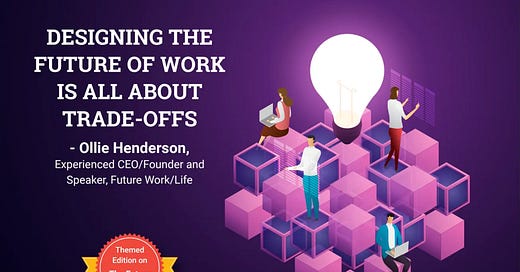Future Work/Life is my newsletter in which I explore ideas focused on the future of work and how to design legendary careers. If you find it interesting, please share it!
I wrote the cover article for HR.com’s Talent Management Excellence magazine, so I thought I’d share it with you. Read on if you’d like to discover how to turn history’s greatest work/life revolution into a positive for you and your team!

When making big changes – whether at work or in life – it's easy to resort to binary thinking – things must be one way or another. But these decisions needn't exist at extremes. There's always a spectrum across which lies the best and most appropriate solution.
Take hybrid work, for example. Initially, the debate was whether remote or in-office was best. Now, we've moved on to how many days in the office we need each week. Progress, I suppose, but such a limited scope means we might just have the worst of both worlds:
The misguided assumption by businesses that by simply congregating for a couple of days you inherently create magic.
And irritated employees who have become accustomed to having autonomy over their time.
The reaction to this conversation is no less problematic.
When disgruntled workers express their misgivings about having to return to the office, there's a chorus from a certain group (typically of vested interests and with a more old-fashioned view of the world) that "you should be careful what you wish for." As their analysis goes: for businesses employing fully remote teams, they may as well be in Bangalore or Bangkok as Basingstoke, Baltimore or Berlin.
The thing is, they're right - the development of a global workforce is well and truly in motion, and there's no point pretending otherwise.
But rather than consider this as a chance to reimagine work and create new opportunities for your business and people (wherever they’re based) to thrive, it’s delivered as doom-mongering.
So what should you do instead?
How can you turn these fundamental shifts in work and the labour market into positives?
Well, try pausing and analysing what ‘ideal’ looks like. Suppose you regard in-person interactions to add significantly to company culture, productivity, and creativity. How much will you sacrifice a bigger talent pool to satisfy your hypothesis? I mean, literally, how much?
Do you believe having a physical space and consistent IRL (in real life) connection adds 30% to the bottom line?
10%?
5%?
Now, weigh that up against the upside of a wider talent net to support your company's growth. Without a doubt, a global market means your ability to hire top-calibre people increases. So, literally, how much will that contribute to the growth of your business?
Will it add 30% to the bottom line?
10%?
5%?
You see where I'm going with this, right?
It's a trade-off.
If you believe the talent benefit will increase your growth by 50%, while the hybrid work strategy would contribute a 10% upside, it's easy to see the best approach - go remote. If the difference is marginal, then perhaps you take a hybrid approach, focusing on building the best possible workspace to bring the best out of your team. It's often tricky to quantity these things exactly, but it's not impossible.
And since the world has so dramatically changed, you don’t need to stick to the same rules as before.
Break it down by team or department: some roles and functions lend themselves to distributed teams, and others perform better when they work together in the same physical space.
For those who benefit from proximity, what's the optimal frequency? Every week, every month, every quarter? Many of the most successful remote-first businesses schedule a regular company get-together every quarter, which is enough to build trust and familiarity within teams and across departments. Others thrive being in the same space every day, something it's impossible to recreate over a video call.
Rather than settling for the simple binary choice, take a future-focused mindset and explore how reimagining work will allow you to attract the best talent and grow.
So how can you build a model that helps develop a growth culture?
Follow the principles I’ve written about in Work/Life Flywheel.
𝗠𝗜𝗡𝗗𝗦𝗘𝗧: Understand what matters to people and ensure their values and goals align with the business.
𝗖𝗥𝗘𝗔𝗧𝗜𝗩𝗜𝗧𝗬: The difference between the best and rest? Their ability to think differently and act creatively. Unleash it!
𝗘𝗫𝗣𝗘𝗥𝗜𝗠𝗘𝗡𝗧𝗔𝗧𝗜𝗢𝗡: The most innovative companies constantly test and learn. Embrace this philosophy with how people work (e.g. encouraging side projects and cross-department deployments).
𝗖𝗢𝗠𝗠𝗨𝗡𝗜𝗧𝗬: People value connection, but don’t restrict yourself to the most obvious options. Think beyond just remote or hybrid to new ways of building relatedness and community.
𝗟𝗘𝗔𝗥𝗡𝗜𝗡𝗚: Constant progress and growth are critical to those who make a difference to your business's success. Prioritise developing systems for formal and informal learning.
𝗕𝗥𝗘𝗔𝗞𝗧𝗛𝗥𝗢𝗨𝗚𝗛𝗦: Nothing great comes if you’re burnt out with no time to stop and reflect on your progress. Create a culture that encourages people to proactively schedule downtime.
There's an inherent complexity in taking a more multi-dimensional approach to work/life design, which increases significantly with larger organisations. But the data is there if you look for it, whether in feedback from managers and employees or in surveys and engagement data. Like any great leap forward, the journey won’t be straightforward. But by accepting and embracing the trade-offs involved, we have the collective opportunity to design a more personalised approach to work.
And be in no doubt, the businesses that get this right will be those that flourish.




